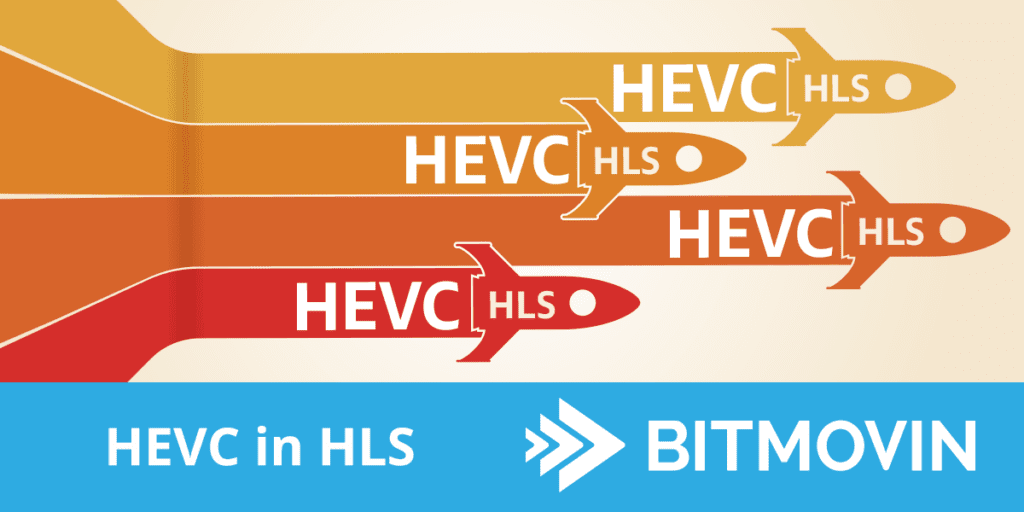Did you know our video player guarantees playback quality on any screen through our modular architecture, including low-latency, configurable ABR and Stream Lab, the world’s first stream QoE testing service? Check out the Bitmovin Player to learn more.
This year Apple announced at their WWDC conference support for HEVC/H.265 with HLS for macOS High Sierra and iOS11
Every year at Apple’s annual Worldwide Developer Conference (WWDC) they present updates and new features that will be available to their products soon. This year Apple announced support for HEVC/H.265 for macOS High Sierra and iOS 11. According to Netflix’s experiments HEVC/H.265 can reach up to 50% bitrate savings compared to AVC/H.264 which allows to stream better quality to customers and saves storage and bandwidth costs for content providers.
We at Bitmovin are of course always especially interested in the video related updates from Apple. Last year we were a first mover to support fMP4 in HLS after Apple announced it at WWDC16. This year we are even in a position where we already support HEVC/H.265 end-to-end in both our products encoding and player.
Multi Codec Support with Bitmovin’s API
With the Bitmovin API you can encode content with different codecs like AVC/H.264, HEVC/H.265, VP9, and recently also AV1 using MPEG-DASH and HLS. This allows to use the best codec for the platform when streaming content to your users. HEVC/H.265 and VP9 are more efficient than AVC/H.264 allowing to deliver higher quality with the same bitrate, or save costs by delivering similar quality to less bandwidth. VP9 is supported on Google Chrome, Firefox and Android devices which allows you to stream VP9 to about 70% of your users. For Safari there was still the need to use AVC/H.264 until now. With the announcement of Apple we will soon see HEVC/H.265 to be streamed to macOS and iOS devices.
With our flexible Bitmovin API generating content encoded in HEVC/H.265 and mux it to fMP4 segments works out-of-the-box as we do that today for HEVC MPEG-DASH content. The trick to make it available as an HLS asset is just to reference the the segments in the playlist files in the same way we do it today with fMP4 in HLS.
Bitmovin HTML5 and Native Players Already Support HLS with HEVC
Apple supports now HEVC video in fMP4 segments in HLS. While this works on iOS 11 and macOS High Sierra only, the reached audience can be extended using the Bitmovin Player. It supports HEVC HLS in all browsers which support HEVC decoding already out of the box. Also the Bitmovin Player iOS SDK is ready for HEVC HLS on iOS 11.
Test Vectors
There are a few ways to deliver HEVC content to users:
- HEVC in HLS using MPEG-2 Transport Stream chunks, which Apple doesn’t support
- HEVC in HLS using fMP4 segments, which is what Apple announced on WWDC17 and our player supports
- HEVC in MPEG-DASH using fMP4 segments
All of these options can already be created using our Bitmovin API. For playback, it depends on the HEVC support in the browser. Obviously, Apple added this for Safari on macOS High Sierra and iOS 11, but also Edge on Windows 10 already supports it. HEVC can be streamed using HLS or MPEG-DASH to Edge with the Bitmovin Player.
We provide test vectors for the three above mentioned types for public testing:
- HEVC HLS with fMP4: http://bitmovin-a.akamaihd.net/content/dataset/multi-codec/hevc/stream_fmp4.m3u8
- HEVC HLS with TS (not supported by Apple): http://bitmovin-a.akamaihd.net/content/dataset/multi-codec/hevc/stream_ts.m3u8
- HEVC MPEG-DASH: http://bitmovin-a.akamaihd.net/content/dataset/multi-codec/hevc/stream.mpd
Beside HEVC/H.265 we can also encode the same asset to AVC/H.264 and VP9 which we introduced earlier this year. With this configuration you can deliver the best codec to every device, improving quality and save costs. VP9 is supported on multiple platforms including Google Chrome, Firefox and Android devices. Google Chrome currently has a market share of 57% in North America and Firefox accounts for roughly 12% in that region. Taking these two alone you could probably reach up to 70% of your users with VP9. So basically 70% of your users could benefit from VP9 which could reduce your bitrate by 50% and lower your CDN costs dramatically.
Here are some more test vectors including the VP9 codec:
- Multi-Codec MPEG-DASH (AVC/H.264, HEVC/H.265, VP9): http://bitmovin-a.akamaihd.net/content/dataset/multi-codec/stream.mpd
- VP9 MPEG-DASH: http://bitmovin-a.akamaihd.net/content/dataset/multi-codec/stream_vp9.mpd
We wish you happy testing and would love to get your feedback!
Popular video technology guides and articles:
- Back to Basics: Guide to the HTML5 Video Tag
- What is a VoD Platform?A comprehensive guide to Video on Demand (VOD)
- Video Technology [2022]: Top 5 video technology trends
- HEVC vs VP9: Modern codecs comparison
- What is the AV1 Codec?
- Video Compression: Encoding Definition and Adaptive Bitrate
- What is adaptive bitrate streaming
- MP4 vs MKV: Battle of the Video Formats
- AVOD vs SVOD; the “fall” of SVOD and Rise of AVOD & TVOD (Video Tech Trends)
- MPEG-DASH (Dynamic Adaptive Streaming over HTTP)
- Container Formats: The 4 most common container formats and why they matter to you.
- Quality of Experience (QoE) in Video Technology [2022 Guide]




